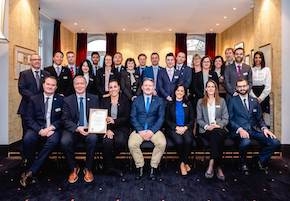- About
- Programs
- Innovation & Research
- Campus Life
- Career Services
- Admissions
- News & Events
- Alumni
Explore 9 Diverse Leadership Styles
Finding the right leadership style is just as much about knowing yourself as it is about understanding your team.
Imagine two leaders: Sarah, who believes in a collaborative approach and constantly engages her team in decision-making processes, and David, who prefers a more directive style, providing clear instructions and expectations. Despite their vastly different methods, both Sarah and David achieve remarkable success within their respective teams. This contrast exemplifies that there isn't a one-size-fits-all leadership style that guarantees success. Instead, it's about understanding the unique dynamics of your team and effectively employing the strategies that resonate with them.
Continue reading to learn more about the types of leadership styles and discover which one might be the perfect fit for you. You'll gain insights into how to harness different approaches to inspire and lead your team effectively. After all, finding the right leadership style is just as much about knowing yourself as it is about understanding your team.
What Are Leadership Styles?
Leadership styles represent the different approaches and methods that leaders use to guide, motivate, and manage their teams. These styles are shaped by various factors, including personality, organizational culture, and specific situational demands. By recognizing and adapting different styles, leaders can effectively address the diverse needs of their teams and, thus, help optimize performance.
9 Different Leadership Styles
The effectiveness of a leader often hinges on their leadership style, which can significantly impact team dynamics, morale, and productivity. Therefore, it's important to be informed about the different styles and their strengths and weaknesses. Below, we'll explore nine distinct leadership styles and their defining characteristics.
Servant leadership
Servant leadership is based on a leadership philosophy where the leader's main goal is to serve. These leaders prioritize the needs of their team members and encourage their personal and professional growth. Key characteristics include empathy, listening, stewardship, and a commitment to building community.
One of the significant advantages of servant leadership is that it nurtures a strong sense of community and collaboration. Team members feel valued and empowered, leading to higher morale and productivity. However, a common challenge is that this leadership style can be time-consuming and may not be as effective in high-pressure or fast-paced environments where quick decisions are necessary.
This leadership style is most effective in organizations prioritizing long-term development and employee well-being. It particularly suits non-profit organizations, educational institutions, and companies that value corporate social responsibility. It works well when the goal is to build a supportive and inclusive culture.
Transformational leadership
Transformational leadership is characterized by the leader's ability to inspire and motivate followers to exceed their own self-interests for the good of the organization. It's a style where leaders work with their teams to identify needed change, create a vision to guide that change, and, finally, execute it in tandem with the group.
The main advantage of transformational leadership is its ability to inspire and motivate employees, leading to higher levels of innovation and performance. However, it can also lead to burnout if the vision is too challenging or if employees are not given the necessary support to achieve it.
This style is generally most effective in environments that require change or innovation, organizations that need to adapt quickly to new conditions, or those looking to re-energize their workforce. It works best with employees who are open to change and are motivated by a sense of purpose.
Transactional leadership
Transactional leadership, as the name suggests, focuses on the exchanges that occur between leaders and their followers. It is characterized by clear structures, rules, and rewards for achieving short-term goals.
While transactional leadership offers the advantage of clarity and structure, it can also be demotivating over time. Employees may feel their personal growth and creativity are stifled by rigid procedures and an excessive focus on rewards and punishments, potentially leading to decreased morale and productivity.
The transactional leadership style is most effective in organizations that need to achieve specific, short-term goals. It is useful in environments where tasks are clear-cut and processes must be followed meticulously, such as manufacturing or sales-driven businesses.
Autocratic leadership
Autocratic leadership, a style where the leader unilaterally makes decisions, is characterized by individual control over all decisions and minimal input from group members. Leaders using this style often base their choices on their own ideas and judgments, seldom seeking advice from followers.
Although it can lead to quick decision-making and clear directives, this style often lacks creative solutions. More importantly, it can lead to high levels of employee dissatisfaction and turnover due to its authoritarian nature, which can have a detrimental effect on the organization's overall performance.
Autocratic leadership is most effective when quick decision-making is crucial, such as during a crisis or when strict compliance is necessary. It can also be effective with employees who require close supervision and are less experienced.
Democratic leadership
Democratic leadership, also referred to as participative leadership, involves team members in the decision-making process. Leaders who practice this style encourage open communication and the sharing of ideas, promoting a sense of ownership among team members.
Employing this leadership style can lead to higher levels of employee satisfaction and creativity since team members feel their opinions are valued. However, decision-making can be time-consuming and may lead to conflicts if team members have differing opinions.
Democratic leadership is most effective in environments that value team collaboration and creativity. It works well in organizations that need innovative solutions and have the time to invest in thorough decision-making processes. It is also beneficial when the leader wants to develop future leaders within the team.
Your Leadership Journey Starts Here
Master the art of hospitality management
Laissez-faire leadership
This leadership style is a hands-off approach where leaders provide minimal direction and allow group members to make decisions. It is characterized by a high level of trust and freedom for employees to manage their own work and make decisions.
The main advantage of laissez-faire leadership is that it can lead to high levels of innovation and employee satisfaction, as team members have the freedom to explore and implement their ideas. But, it can also lead to a lack of direction and accountability.
The laissez-faire leadership style is ideal in creative industries or research and development departments where innovation and independent work are highly valued. It's most effective in organizations with highly skilled and self-motivated employees who require little supervision.
Bureaucratic leadership
The bureaucratic leadership style focuses on following rules and procedures to manage teams and projects. This style is characterized by strict adherence to formal rules and a clear hierarchy of authority, ensuring that employees follow defined processes and standards.
Its main advantages are consistency and reliability, which can be crucial in highly regulated industries. However, due to its rigid structure, it can stifle creativity and innovation and may lead to a slow decision-making process.
Bureaucratic leadership is most effective in organizations that operate in highly regulated environments, such as government agencies or financial institutions, where following rules and procedures is essential. It is also beneficial in situations where maintaining consistency and quality is crucial.
Coaching leadership
Coaching leadership involves leaders who focus on their team members' professional and personal growth. This style is characterized by a leader who acts as a mentor or coach, providing support and feedback to help employees develop their skills and achieve their goals.
The main advantage of coaching leadership is that it fosters a culture of continuous learning and development, which can lead to high levels of employee satisfaction and performance. However, it can be time-consuming and may not be suitable for all team members, particularly those not open to feedback or personal development.
Coaching leadership is most effective in organizations that prioritize employee development and growth. It works well in environments where continuous learning is valued, such as education, training, or professional development settings. It is also beneficial for teams that need to develop specific skills or competencies.
Pacesetting leadership
Pacesetting leadership sets high standards and expects its team members to meet them. This style is characterized by a leader who leads by example, demonstrating the high levels of performance and excellence they expect from their team.
The main advantage of pacesetting leadership is that it can drive high levels of performance and productivity. However, it can also lead to burnout and high-stress levels among team members if the pace and expectations are too demanding.
Pacesetting leadership is most effective in environments where high performance and quick results are crucial. It works well in competitive industries or sales-driven organizations where achieving targets and maintaining a high level of performance is essential. It is also beneficial when working with highly skilled and motivated employees who thrive in high-pressure environments.
Choosing the Right Leadership Style
Organizational culture, team dynamics, and the nature of tasks significantly influence the choice of leadership style. For example, transformational or laissez-faire leadership may be ideal in organizations valuing innovation and creativity. In other cases, some highly regulated companies might thrive under bureaucratic leadership.
The team's skills, experience, and motivation levels also matter. A highly skilled team may excel under a laissez-faire style, while a diverse team with varying experience levels might benefit from democratic or coaching leadership. The complexity and urgency of tasks are crucial, too; routine tasks might require transactional leadership, while complex projects could benefit from transformational leadership.
Ultimately, flexibility and adaptability are paramount for leadership. Circumstances change, and a one-size-fits-all style is often ineffective. Therefore, leaders must assess situations and adjust their style accordingly. For example, a leader might use a democratic style to encourage collaboration but switch to an autocratic approach in an emergency. The best leaders blend various approaches to meet their organization's, team's, and tasks' specific needs, enhancing their overall effectiveness.
Impact of Leadership Styles on Team Dynamics
The leadership style adopted by a leader significantly influences team dynamics, including communication, collaboration, motivation, and overall performance. For instance, democratic leadership builds a culture of openness and participation, leading to higher employee satisfaction and creativity. On the other hand, autocratic leadership may ensure efficiency and quick decision-making but could result in low morale and high turnover.
Understanding the strengths and limitations of each leadership style allows leaders to create a positive and productive work environment. By aligning their leadership approach with the needs and values of their team, leaders can enhance team cohesion, drive performance, and achieve organizational goals.
The Bottom Line
At the end of the day, the key is to recognize that using different approaches with your team is as important as finding the one style that best suits you. Each leadership style has its own advantages and disadvantages, and there is no single correct style. Success hinges on possessing the necessary qualities to lead, guide, and support your team. By understanding and adapting to the unique needs of your team and the challenges you face, you can succeed with any leadership style.
If you are ready to enhance your leadership skills and explore the world of leadership, consider joining our Master of Science in Leadership program. Equip yourself with the knowledge and expertise to navigate various leadership styles and become a versatile, successful leader!
Frequently Asked Questions (FAQs)
Which leadership style is most effective in promoting innovation?
Transformational leadership is one of the most effective styles in promoting innovation. It inspires and motivates team members to go beyond their own self-interests for the good of the organization, fostering a culture of creativity and continuous improvement.
What strategies can leaders use to transition between different leadership styles based on evolving team needs?
Leaders can use regular feedback and team assessments to understand evolving needs and adjust their style accordingly. Training and development programs can help them build the necessary skills for different styles, while open communication ensures team members are aligned with changes in leadership approaches.
Your Leadership Journey Starts Here
Master the art of hospitality management

















